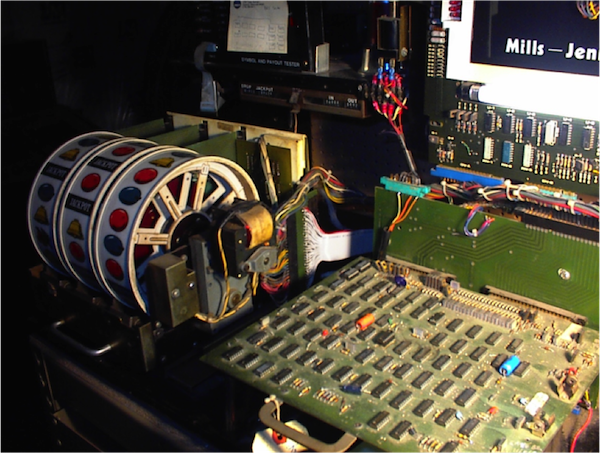Most of us have played games like poker and blackjack with friends. Up to a point, these games can be great fun. Unlike other forms of play, however, gambling taps into a side of the human mind that encourages damaging behavior, often to the point that many people have stories about friends or relatives who have lost everything to gambling.
Video gambling describes slot machines and the other electronic machines found in most casinos. Vastly profitable— generating up to 70% of casino revenues in the U.S.—these machines are also examples of experiences designed to manipulate user behavior.
The way gambling companies justify their revenue source is intriguing: they promote it as social and fun while also claiming to help people with gambling problems. Behind the scenes, however, they engage in all kinds of “optimizations” that encourage gamblers to spend and play more without stopping or burning out.
How do I know this? I have something to confess.
Early in my career I was one of those “dark side” UX designers at a video gambling company. I’m not proud of it, but I learned a lot about the psychological techniques they use. People often say that gambling companies are the masters of the dark side of UX and gamification, but not many of us know the details. I do, and I’m going to share them with you in this article, which supports a presentation of the same name that I’ve given on the topic.
From Seduction to Deception
As with many relationships, gambling starts with a seduction phase. The experience of walking into a casino is carefully crafted to deliver the promise of fun, pleasure, and riches using a heady combination of lights, music, and fantasy. It’s no accident that the gambling machines are branded with themes from popular culture: they are designed to make you feel comfortable, appeal to you sexually, or provide aspirations to a new, higher social status. You may find it hard to believe but this stuff really works.
In-Game Patterns
Video gambling machines are designed to be easy to walk-up to and play. The learning curve is minimal. Once they’ve got you playing then a number of “dark patterns”—user interfaces designed to trick—are applied.
A disparity between perceived and real odds
The user interfaces on many machines hark to the old days with a physical lever that you pull and dials that spin around, alluding to the idea of natural randomness: like rolling dice or picking a card from a shuffled deck. In fact, the machine runs on software that tells the dials exactly how to spin and where to stop.
Although random number generators are used, the bounds of the randomness are predetermined, and the payout rate is set in favor of the house by about 10%. What’s fascinating is that many casinos make this fact public on large signs (e.g. “The payout rate on these machines is 90%! Play now!”). Gamblers continue to play, in an attempt to beat or “game” a system that has been specifically designed from the ground-up to game them.
The gambler’s reasoning is that although the house takes 90% of the money put in, this figure is an average across the entire population of players and, as an individual, they still stand to win a large amount. Of course, all gambling odds are stacked in favor of the house. What’s fascinating about video gambling is the extent to which this is engineered. For example, slot machines are often networked, not just within single casinos but across multiple casinos, allowing payouts to be adjusted between games to meet profit margins.
High bet buttons are prominent, low bet buttons are hidden
All UX designers know that it’s important to show a clear and prominent call-to-action to convert your business needs. This is why the “create account” button on a website tends to be big, and the “delete account” button tends to be a small text link tucked away deep in the settings page.
The exact same principle is used in video gambling machines. The big prominent buttons are always the ones that encourage you to spend more and continue gambling. The buttons that allow more sensible behavior tend to be just a little smaller or harder to find. When averaged over millions of players, these small design tweaks have a big impact.
The game’s rules are so clear that you do not need to worry about learning curves. The thrill is there and the jackpot is poised to make you rich—why shouldn’t you play longer? Deception goes along with dark patterns, unnoticed and exploiting psychological resorts of your mind.
Here are some examples.
- Interface is designed deliberately so you spend longer looking for the low bet button (when it exists) or the cash out button. Conversely, betting buttons and their placement make very easy to keep playing or gamble it all.
- You end up not noticing how many times you’ve lost because you “win” a few small or medium prizes as you play, but you’ve still lost more money than what you’ve won back.
- “Near misses”—one of the better-known tricks that makes you feel like you’ve just missed out on a win. This excitement causes your brain to release dopamine, creating a natural high. This is similar to the concept of “perceived scarcity”—also used in marketing to convince consumers that an offer is limited and they must buy it as soon as possible.
- Changing the currency from Dollars to credits hides from you the real money you’re spending. By giving you control with the bet and the value of the credit, you lose your perception of money. Now it is just time in the machine: more credits equals longer play. Another careful ploy used is when a prize is won the sound of clinking coins is played to make you feel like you’ve won real money, not just credits.
The Grey Zone Is Not Flow
What started with seduction and a promise of riches has slowly become a relationship based on deception. A gambler’s state of mind is far from Csikszentmihalyi’s flow, in which an activity produces an experience so gratifying that people are willing to perform it for its own sake. When gambler’s play video gambling machines, they want to get in what they call “the zone” because they can forget the rest of the world. This is different from the flow, as they do not experience clarity and do not need a motivation to achieve any goal. It’s pure escapism.
Natasha Schull explains “the zone” in her recently published book Addiction By Design. She interviews true gamblers to explain their experiences losing their sense of time in front of the machine: minutes turn into hours, hours into days. The “Auto” button which allows not pressing any buttons at all to keep playing is perfect for this purpose—pushing the user into gambling in a more automatized way.
When gamblers are in the zone they become a money making machine. But these companies and casinos don’t just stop with the machines. In the early ‘00s the Harrah’s casino in Las Vegas hired a young PhD in economics named Gary Loveman who applied data mining to the gambling information system and created a loyalty program with massive success. Analyzing the data in real-time allowed seeing which users could play longer and what game and casino floor design changes were more profitable. Other companies copied the method and user research converted gamblers into figures that could be improved by handing out rewards.
Dark Design
Last year, information architecture and UX guru Louis Rosenfeld asserted in a tweet that “User experience is a strain of 21st century humanism.” Think about what UX involves as a discipline: knowing the user needs, coordinating with engineering, and understanding the market. You may not find any other profession with as many inputs from different people and different areas. But an ethical dimension should be fundamental.
The elements of the video gambling experience are like the elements of any other webpage or software: they are designed to match the user needs and they align with the products’ strategy. The problem with video gambling is that user needs are swallowed up by a compulsion to continue using the product, a compulsion that the product is designed to deepen and exploit. These elements are continually enhanced with iterated quantitative research to further optimize the experience, sucking the gamblers further in.
Aligning business needs with user needs can be a delicate balance, but video gambling raises the question of whether or not honesty and integrity should always be the overriding principle in any design choice. In my opinion, optimizing a form or payment system is one thing, but tricking a user into spending more money is another. What do you think?
Image of hand pressing play courtesy Shutterstock









